上海交通大学:《材料加工原理 Principles of Materials Processing》教学资源(课件讲稿)凝固和铸造 Solidification and casting_Nucleation in solidification(2/2)
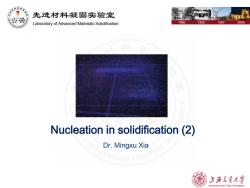
先进材料疑固实验室 Laboratory of Advanced Materials Solidification 1896 1920 1987 2006 ciquidmeta metal with the atomle structure oraliquld Nucleation in solidification(2) Dr.Mingxu Xia anced Mate 周 上浒充通大学 SHANGHAI JIAO TONG UNIVERSITY
1896 1920 1987 2006 Nucleation in solidification (2) Dr. Mingxu Xia

先进材料疑固实验室 Outline Laboratory of Advanced Materials Solidification Solidification Concepts: >Definition >Nucleation free energy Thermo performance >Nucleation barrier Conventional Nucleation Theory >Critical nucleus >Homogeneous nucleation Heterogeneous nucleation >Nucleation rate Nucleation rate and its control Nucleation rate >Grain refining >Metallic glass Further Nucleation in atomic level Non-Conventional Nucleation Theory nced 上浒充通大学 SHANGHAI JIAO TONG UNIVERSITY
Outline Solidification Definition Thermo performance Conventional Nucleation Theory Homogeneous nucleation Heterogeneous nucleation Nucleation rate and its control Nucleation rate Grain refining Metallic glass Further Nucleation in atomic level Non-Conventional Nucleation Theory Concepts: Nucleation free energy Nucleation barrier Critical nucleus Nucleation rate
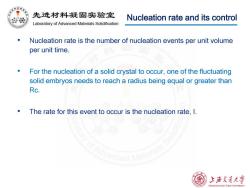
先进材料疑固实验室 Nucleation rate and its control Laboratory of Advanced Materials Solidification Nucleation rate is the number of nucleation events per unit volume per unit time. For the nucleation of a solid crystal to occur,one of the fluctuating solid embryos needs to reach a radius being equal or greater than Rc. The rate for this event to occur is the nucleation rate,1. 上降充通大学 SHANGHAI JIAO TONG UNIVERSITY
Nucleation rate and its control • Nucleation rate is the number of nucleation events per unit volume per unit time. • For the nucleation of a solid crystal to occur, one of the fluctuating solid embryos needs to reach a radius being equal or greater than Rc. • The rate for this event to occur is the nucleation rate, I
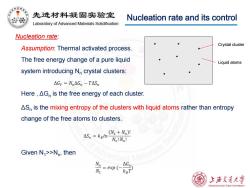
先进材料疑固实验室 Nucleation rate and its control Laboratory of Advanced Materials Solidification Nucleation rate: Crystal cluster Assumption:Thermal activated process. The free energy change of a pure liquid Liquid atoms system introducing N crystal clusters: △Gv-Nn△Gn-T△Sm Here,AG is the free energy of each cluster. AS is the mixing entropy of the clusters with liquid atoms rather than entropy change of the free atoms to clusters. △Sn=kal (N1+Nn)! N!N! Given N >>Nn,then G =ep( 上降充通大学 SHANGHAI JIAO TONG UNIVERSITY
Nucleation rate and its control Nucleation rate: Assumption: Thermal activated process. The free energy change of a pure liquid system introducing Nn crystal clusters: Here , ΔGn is the free energy of each cluster. Crystal cluster Liquid atoms ΔSn is the mixing entropy of the clusters with liquid atoms rather than entropy change of the free atoms to clusters. Given N1>>Nn , then

积 先进材料疑固实验室 Nucleation rate and its control Laboratory of Advanced Materials Solidification A nucleus of critical size Rc will grow if it manages to add one more atom.The rate at which this occurs is proportional to the atomic vibration frequency vo and the probability of capturing an atom at the surface,p.Thus,the rate of formation of homogeneous nuclei, Ihomo,iS Thomo =VoPenn VoPeniexp( △G Set Iomo=voPenI As an example,we use the date for Al,n=6x1028 atoms/m3,the atomic vibration frequency being about 1013s-1 at T let's assume that there is no difficulty in attaching an atom to the surface of the nucleus,i.e.,p=1. Then, I8om0=6×1041 上浒充通大学 SHANGHAI JIAO TONG UNIVERSITY
Nucleation rate and its control A nucleus of critical size Rc will grow if it manages to add one more atom. The rate at which this occurs is proportional to the atomic vibration frequency ν0 and the probability of capturing an atom at the surface, pc . Thus, the rate of formation of homogeneous nuclei, Ihomo, is Set As an example, we use the date for Al, nl=6x1028 atoms/m3 , the atomic vibration frequency being about 1013s -1 at Tf , let’s assume that there is no difficulty in attaching an atom to the surface of the nucleus, i.e., pc=1. Then
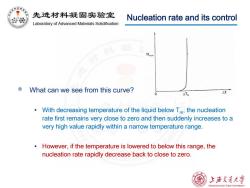
先进材料疑固实验室 Nucleation rate and its control Laboratory of Advanced Materials Solidification What can we see from this curve? △TW △T o With decreasing temperature of the liquid below Tm,the nucleation rate first remains very close to zero and then suddenly increases to a very high value rapidly within a narrow temperature range. However,if the temperature is lowered to below this range,the nucleation rate rapidly decrease back to close to zero. 上游文通大¥ SHANGHAI JIAO TONG UNIVERSITY
What can we see from this curve? • With decreasing temperature of the liquid below Tm, the nucleation rate first remains very close to zero and then suddenly increases to a very high value rapidly within a narrow temperature range. • However, if the temperature is lowered to below this range, the nucleation rate rapidly decrease back to close to zero. Nucleation rate and its control

先进材料疑固实验室 Nucleation rate and its control Laboratory of Advanced Materials Solidification The reasons for this phenomenon: With decreasing temperature of the liquid,the magnitude of the nucleation barrier decreases>a higher nucleation rate,but atom diffusivity also decreases >a lower nucleation rate. These two opposite effects of decreasing temperature lead to a temperature at which the nucleation rate reaches its maximum. vanced Materd 上游充通大学 SHANGHAI JIAO TONG UNIVERSITY
Nucleation rate and its control The reasons for this phenomenon: • With decreasing temperature of the liquid, the magnitude of the nucleation barrier decreases a higher nucleation rate, but atom diffusivity also decreases a lower nucleation rate. • These two opposite effects of decreasing temperature lead to a temperature at which the nucleation rate reaches its maximum

先进材料疑固实验室 Nucleation rate and its control Laboratory of Advanced Materials Solidification When the cooling rate is very high,the nucleation of solid crystal may be avoided in the process of rapid cooling of the liquid metal or alloy until the liquid turns into a solid through glass transition.This solid is called metallic glass. vanced Materials S 上游充通大学 SHANGHAI JIAO TONG UNIVERSITY
Nucleation rate and its control • When the cooling rate is very high, the nucleation of solid crystal may be avoided in the process of rapid cooling of the liquid metal or alloy until the liquid turns into a solid through glass transition. This solid is called metallic glass
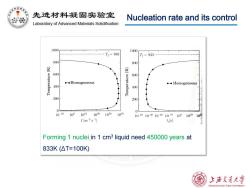
先进材料疑固实验室 Nucleation rate and its control Laboratory of Advanced Materials Solidification 1(000 1000 T=933 Tr=933 800 800 600 [y]ainqeiadwaL 600 ◆◆Homogeneous 。◆Homogeneous 400 400 200 200 0 1010 109 100 1020 1030 100 10401030102010101001010 102 1m3s1 n母 Forming 1 nuclei in 1 cm3 liquid need 450000 years at 833K(△T=100K 上游文通大¥ SHANGHAI JIAO TONG UNIVERSITY
Nucleation rate and its control Forming 1 nuclei in 1 cm3 liquid need 450000 years at 833K (ΔT=100K)

先进材料疑固实验室 Nucleation rate and its control Laboratory of Advanced Materials Solidification Heterogeneous nucleation rate: Thotero vopenn=VoPeniexp( 1000 1000 T,=933 T= 33- S00 S00 三 600 00 。◆Homogeneous ◆◆Homogeneous 400 o-o Hetero.030 o-o Hetero.30 。■Hetero.0=r/20) 。Hetero.∥=T/20 Hetero,0=π/A ▲Hetero.∥=a/I 200 Hetero,∥=r/2 Hetero.0/2 ◆◆Hetero.0=r 200 ◆Hetero,a=r 直 1010 1 10o 10 10 10 10010010201010100 1010 102 /3s Ls ced 上游文通大学 SHANGHAI JIAO TONG UNIVERSITY
Nucleation rate and its control Heterogeneous nucleation rate:
按次数下载不扣除下载券;
注册用户24小时内重复下载只扣除一次;
顺序:VIP每日次数-->可用次数-->下载券;
- 上海交通大学:《材料加工原理 Principles of Materials Processing》教学资源(课件讲稿)凝固和铸造 Solidification and casting_Nucleation in solidification(1/2).pdf
- 上海交通大学:《材料加工原理 Principles of Materials Processing》教学资源(课件讲稿)凝固和铸造 Solidification and casting_Transport phenomena in solidification(2/2).pdf
- 上海交通大学:《材料加工原理 Principles of Materials Processing》教学资源(课件讲稿)凝固和铸造 Solidification and casting_Transport phenomena in solidification(1/2).pdf
- 上海交通大学:《材料加工原理 Principles of Materials Processing》教学资源(课件讲稿)凝固和铸造 Solidification and casting_Structure and properties of liquid metals(2/2).pdf
- 上海交通大学:《材料加工原理 Principles of Materials Processing》教学资源(课件讲稿)凝固和铸造 Solidification and casting_Structure and properties of liquid metals(1/2).pdf
- 上海交通大学:《材料加工原理 Principles of Materials Processing》教学资源(课件讲稿)凝固和铸造 Solidification and casting_Brief of statistic thermodynamics.pdf
- 上海交通大学:《材料加工原理 Principles of Materials Processing》教学资源(课件讲稿)凝固和铸造 Solidification and casting_Introduction to solidification and casting.pdf
- 上海交通大学:《材料连接原理与工艺》课程教学资源(课件讲稿)第四章 焊接接头的组织和性能.pdf
- 上海交通大学:《材料连接原理与工艺》课程教学资源(课件讲稿)第五章 焊接缺陷.pdf
- 上海交通大学:《材料连接原理与工艺》课程教学资源(课件讲稿)第二章 焊接热过程.pdf
- 上海交通大学:《材料连接原理与工艺》课程教学资源(课件讲稿)第三章 焊接化学冶金.pdf
- 上海交通大学:《材料连接原理与工艺》课程教学资源(课件讲稿)第一章 绪论(芦凤桂).pdf
- 上海交通大学:《材料美学》课程教学资源(课件讲义)隐身与防弹材料(宁月生).pptx
- 上海交通大学:《材料美学》课程教学资源(课件讲义)材料美学——古典性能美.ppt
- 上海交通大学:《材料综合实验》课程教学学课件(讲稿)硬度教学.pdf
- 上海交通大学:《材料与社会 Materials & Society》课程教学资料(作业论文)玻璃与水晶.pptx
- 《生态环境材料学》课程教学资源:生态材料论(北京科技大学材:肖纪美).pdf
- 上海交通大学《生态环境材料学》:材料科学的一个新生长点——生态材料学.pdf
- 上海交通大学:《生态环境材料学 Ecomaterialogy》课程教学资源(课件讲稿)生态环境材料(生态材料学).pdf
- 上海交通大学:《生态环境材料学 Ecomaterialogy》课程教学资源(课件讲稿)生态环境材料(钢铁).pdf
- 上海交通大学:《材料加工原理 Principles of Materials Processing》教学资源(课件讲稿)凝固和铸造 Solidification and casting_Heat flow during the solidification process.pdf
- 上海交通大学:《材料加工原理 Principles of Materials Processing》教学资源(课件讲稿)凝固和铸造 Solidification and casting_Crystal growth of single element solids 1/3(Liquid/solid interface).pdf
- 上海交通大学:《材料加工原理 Principles of Materials Processing》教学资源(课件讲稿)凝固和铸造 Solidification and casting_Crystal growth of single element solids 2/3(Crystal growth of single element solids).pdf
- 上海交通大学:《材料加工原理 Principles of Materials Processing》教学资源(课件讲稿)凝固和铸造 Solidification and casting_Crystal growth of single element solids 3/3(Crystal growth methods(technology)).pdf
- 上海交通大学:《材料加工原理 Principles of Materials Processing》教学资源(课件讲稿)凝固和铸造 Solidification and casting_Solidification of single phase alloys(1).pdf
- 上海交通大学:《材料加工原理 Principles of Materials Processing》教学资源(课件讲稿)凝固和铸造 Solidification and casting_Solidification of single phase alloys(2).pdf
- 上海交通大学:《材料加工原理 Principles of Materials Processing》教学资源(课件讲稿)凝固和铸造 Solidification and casting_Solidification of single phase alloys(3).pdf
- 上海交通大学:《材料加工原理 Principles of Materials Processing》教学资源(课件讲稿)凝固和铸造 Solidification and casting_Solidification of single phase alloys(3).pdf
- 上海交通大学:《材料加工原理 Principles of Materials Processing》教学资源(课件讲稿)凝固和铸造 Solidification and casting_Solidification of single phase alloys(3).pdf
- 上海交通大学:《材料加工原理 Principles of Materials Processing》教学资源(课件讲稿)凝固和铸造 Solidification and casting_Solidification of multi phase alloys(1).pdf
- 上海交通大学:《材料加工原理 Principles of Materials Processing》教学资源(课件讲稿)凝固和铸造 Solidification and casting_Solidification of multi phase alloys(2).pdf
- 上海交通大学:《材料加工原理 Principles of Materials Processing》教学资源(课件讲稿)凝固和铸造 Solidification and casting_Solidification of multi phase alloys(2).pdf
- 上海交通大学:《材料加工原理 Principles of Materials Processing》教学资源(课件讲稿)凝固和铸造 Solidification and casting_Metal Casting Technology(1).pdf
- 上海交通大学:《材料加工原理 Principles of Materials Processing》教学资源(课件讲稿)凝固和铸造 Solidification and casting_Metal Casting Technology(2).pdf
- 上海交通大学:《材料加工原理 Principles of Materials Processing》教学资源(课件讲稿)凝固和铸造 Solidification and casting_Metal Casting Technology(3).pdf
- 上海交通大学:《材料加工原理 Principles of Materials Processing》教学资源(课程讲稿)01. Technology of plasticity——Introduction.pdf
- 上海交通大学:《材料加工原理 Principles of Materials Processing》教学资源(课程讲稿)02. Technology of plasticity——Processing maps.pdf
- 上海交通大学:《材料加工原理 Principles of Materials Processing》教学资源(课程讲稿)03. Technology of plasticity——Elements of plastic theory.pdf
- 上海交通大学:《材料加工原理 Principles of Materials Processing》教学资源(课程讲稿)04. Technology of plasticity——plastic deformation mechanism.pdf
- 上海交通大学:《材料加工原理 Principles of Materials Processing》教学资源(课程讲稿)05. Technology of plasticity——Recovery & recrystallization.pdf
